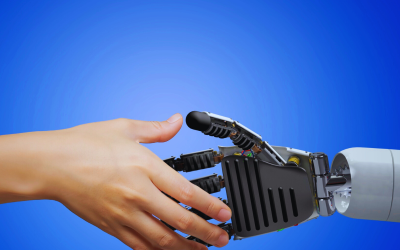In modern retail, UX design is transforming shopping experience at every touchpoint. This article explores how user experience design influences omnichannel retail, with a special focus on POS systems, interactive kiosks, and the future prospects offered by artificial intelligence. We’ll discover how these technologies are reshaping customer-store interactions, creating more fluid and personalized shopping experiences.
Topics Covered:
- The importance of UX design in omnichannel retail
- Facilitating interaction with POS and Kiosks
- Personalization and accessibility
- UX design strategy for omnichannel retail
- The future of retail: artificial intelligence
- Experimentation in omnichannel retail
- Conclusions
The Importance of UX Design in Omnichannel Retail: POS, Kiosks and Artificial Intelligence
The digital era has revolutionized the retail world, making the integration of advanced technologies essential for providing a unified experience. In this context, user experience (UX) design plays a crucial role, especially when it comes to tools like Point of Sale (POS) systems and interactive kiosks. This article explores the role of UX design in omnichannel retail, also analyzing the future potential of artificial intelligence (AI) in this sector.
Facilitating Interaction with POS and Kiosks
POS: An Efficient Sales Experience
A well-designed POS system is essential for improving operational efficiency and reducing transaction errors. An intuitive user interface allows employees to quickly learn how to use the system, reducing training time and increasing productivity. Clarity in command layout and a well-structured workflow help reduce waiting times, improving customer satisfaction.
Kiosk: Accessible Self-Service
Interactive kiosks must be designed to be easily used by customers of all ages and technical abilities. This means implementing simple navigation, clear buttons, and providing immediate feedback for every action taken. Kiosks can offer self-service options such as payment, product ordering, and information consultation, further reducing wait times and improving the overall experience. Here are some examples:
- Nike: Nike has implemented interactive kiosks in its stores to allow customers to customize their shoes. Customers can choose colors, materials, and add unique details through the kiosks, making the shopping experience more engaging and personalized.
- Rebecca Minkoff: Rebecca Minkoff stores use smart mirrors and interactive kiosks in fitting rooms. Customers can select items to try on, request different sizes, and receive style suggestions based on what they’re trying.
- H&M: H&M has experimented with interactive kiosks that allow customers to see how various garments combine, offering suggestions for complete outfits and coordinated accessories.
Personalization and Accessibility: Key Elements
Personalization is a key element in creating an engaging shopping experience. POS systems can be integrated with CRM (Customer Relationship Management) software to provide employees with detailed customer information, enabling them to offer personalized service. Similarly, kiosks can use demographic and behavioral data to personalize offers and recommendations, making the interaction more relevant to the customer.
Accessibility for All
Ensuring the accessibility of POS systems and interactive kiosks is fundamental. This includes designing interfaces that are usable by people with disabilities, such as screens positioned at different heights, readable text, and audio/visual options. An accessible design not only broadens the customer base but also demonstrates a commitment to inclusivity.
UX Design Strategy for Omnichannel Retail
Research and User Testing
Understanding customer needs and behaviors through in-depth research is the first step in designing an effective user experience. Conducting regular user testing allows for collecting valuable feedback and continuously improving the interface. It’s not enough to analyze data from a technological standpoint; when it comes to physical retail, it’s essential to be present in person to observe and receive feedback directly from customers.
Intuitive and Consistent Design
Clear and consistent visual design is essential. Uniform colors, fonts, and layouts make the interface recognizable and easy to use. The most frequently used functions must be easily accessible, avoiding overwhelming the user with too much information.
Omnichannel Integration
POS systems and kiosks must integrate with other sales and customer service platforms, offering a seamless experience between physical and online stores. Efficient integration facilitates inventory management, promotions, and loyalty strategies.
Immediate Feedback
Providing immediate visual or audio feedback for every action taken by the customer is fundamental to reducing uncertainty and improving the overall experience. This makes the interaction more fluid and reassuring.
Staff Training and Maintenance
Training staff to efficiently use POS systems and manage any technical issues or questions about interactive kiosks is crucial. Additionally, keeping systems updated with the latest features and performing regular maintenance ensures optimal functioning.
The Future of Retail: Artificial Intelligence
Automation and Predictive Analysis
Artificial intelligence has the potential to further transform retail. AI systems can automate multiple processes, from inventory management to offer personalization. Predictive analysis allows anticipating customer needs, improving stock management, and optimizing marketing strategies.
Chatbots and Virtual Assistance
AI-based chatbots and virtual assistants can significantly improve customer service, offering 24/7 support and quickly responding to frequent questions. These tools can be integrated into both kiosks and online platforms, ensuring continuous omnichannel support.
Real-time Personalized Experiences
AI can collect and analyze data in real-time to offer highly personalized experiences. For example, POS systems and kiosks can suggest products based on previous purchases or stated preferences, increasing customer satisfaction and sales.
Experimentation in Omnichannel Retail
Augmented Reality (AR) and Virtual Reality (VR)
One of the most promising areas for retail’s future is the use of augmented reality (AR) and virtual reality (VR). These technologies can completely transform the shopping experience. For example, customers can use AR to virtually try on clothes or see how furniture will look in their living room before making a purchase. Interactive kiosks can be equipped with AR to provide additional information about products displayed in store.
The integration of AR and VR in retail can go beyond these initial applications. For instance, IKEA has developed an AR application that allows customers to virtually place furniture in their homes to see how it integrates with the existing environment. Another experimental example is that of VR “virtual stores,” where customers can explore and shop in a completely digital environment as if they were physically present in the store. Walmart has experimented with using VR for employee training, improving their skills without interrupting daily operations.
In the future, retailers could implement “virtual fitting rooms” where customers can try on clothes using VR, saving time and improving the shopping experience. Additionally, AR technologies could be integrated with smartphones to provide personalized offers and real-time promotions when customers are near certain products. As AR and VR technologies evolve, the shopping experience will become increasingly immersive and interactive, revolutionizing how consumers interact with brands and products.
Robotics and Automation
The use of robotics and automation in retail is in an experimental phase but promises to revolutionize the sector. Robots can be used for warehousing tasks, inventory management, and even to assist customers in store, providing product information and guiding them to desired sections. For example, Amazon has already introduced cashierless retail with its Amazon Go stores, which use customer recognition and automatic product reading to allow customers to shop without going through a traditional checkout. Other companies are experimenting with robots for automated shelf management and product delivery within stores, improving efficiency and reducing operational costs.
Machine Learning for Customer Behavior
The introduction of machine learning algorithms can further improve the personalization of the shopping experience. These algorithms can analyze large amounts of data to identify patterns in customer behaviors, allowing retailers to offer increasingly targeted recommendations and promotions. For example, machine learning systems can analyze purchase history, online browsing preferences, and social media interactions to create detailed customer profiles. This enables providing real-time product suggestions, personalizing marketing communications, and even predicting future customer needs. Additionally, machine learning can optimize inventory management, anticipating product demand and reducing the risk of stock shortages or overproduction. Thanks to these technologies, retailers can significantly improve customer satisfaction, increase loyalty, and ultimately increase sales.
Rapid Prototyping and Market Testing
As technologies advance, it becomes increasingly easy and quick to develop prototypes of new tools and solutions for retail. Using rapid prototyping techniques, retailers can test new ideas in small pilot markets, gathering real-time feedback and quickly iterating on proposed solutions.
Conclusions
UX design is essential for the success of omnichannel retail, ensuring smooth and personalized interactions through both POS systems and interactive kiosks. Looking to the future, artificial intelligence will offer new opportunities to further enhance the customer experience, making retail increasingly efficient and people-centered. Experimental technologies like AR, VR, robotics, and machine learning represent the next frontier, promising to transform how we interact with physical and digital stores. By implementing UX design strategies and harnessing AI’s potential, retailers can create shopping experiences that not only meet but exceed customer expectations, maintaining a competitive advantage in an ever-evolving market.


